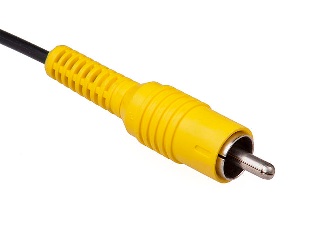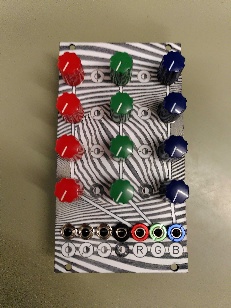The Omega Verksted Video Synth is a modular video synthesizer system. It is connected to a matrix video switch which can route video signals around the room. The rack it is housed in ("The Sofa Rack"), is also intended as a platform for people to experiment with modular synths in general. Currently 3x84HP of eurorack space is installed, fitted with eurorack power supplies for +/-12V providing a total of 18A for each channel.
Analog Video Introduction (WIP)
Analog video was the standard before digital video formats were developed. There are many different standards of analog video. Most are conceptually similar, but they have varying numbers of signal channels (wires, or signal/return pairs), as well as different modulations. They are all based on the analog signal(s) drawing the horizontal lines of the image one by one, and then starting at the top again for the next frame. Some are backwards compatible and/or semi-cross-compatible. Some common standards:
- Composite Video: See below
- S-Video: Successor to composite where black-and-white and coloring signals are separated on two channels
- Component Video is a general term referring to video signals that uses two or more channels. However, it most commonly refers to:
- YPbPr Component Video: (Three-channel format where Y is the luminance (B/W picture) and Pb, Pr are the difference between Y and Blue, Red respectively
- RGB Component Video: Three-channel format where Red, Green and Blue is carried on separate channels. Synchronization pulses may be carried on one of the color channels (most commonly green), or on a separate channel.
- VGA: A five-channel standard with R, G, B, Horizontal Sync and Vertical Sync on separate channels. Recently mostly found on a characteristic blue DSUB-type connector.
The OV video synth uses mainly composite video, but also some YPbPr, and some VGA externally.
Modules
Input + Output (Modified LZX)
Decodes and encodes composite video. Based on:
Knobs:
- L: Luminance (brightness) adjustment of input signal
- K: Contrast adjustment of input signal
Ports:
- Y: Luminance Video Signal (B/W) from main composite input
Cadet IV Dual Ramp Generator (LZX)
Outputs generic ramp signals that correspond to the position on the screen, as defined by the sync signals. Se small icons below each jack to see what kind of ramp.
Top section is horizontal ramps, bottom section is vertical ramps.
Cadet VIII Hard Key Generator (LZX)
Mostly a comparator, which compares an input video signal to a threshold. Areas of the video that are above (brighter than) the threshold are set to max luma, while areas that are not are output as 0.
It also features a control voltage (CV) input which can be added to the input signal.
Top knob: Adjusts the threshold
Bottom knob: Adjusts the scaling of the CV input (-100% to 100%, up is 0%)
4x3 Matrix Mixer (Reverse Landfill)
Matrix mixer that outputs three signals generated from weighted averages of four input signals. Weights are determined with the knobs.
Intended as an RGB mixer towards the end of the signal chain before the composite encoder.
The rows of the knob matrix represent the input signals, while the columns represent the output signals.
YPbPr to RGB Converter (Syntonie)
Converts YPbPr component video to synth-compatible RGB signals. Mounted on the back of the synth.
Quad Frequency Doubler (Syntonie)
Each stage (each pair of jacks from top to bottom) doubles the signal frequency. If no patch is inserted into the next stage, its input becomes the previous stage, and they are chained together to multiply the signal at the input up to 16x. Alternatively, the switching jacks allows you to break the connection between each stage to use them individually.
One stage can be used to:
- Convert a ramp/saw signal to triangle signal
- Multiply a triangle signal by a factor of 2
- Multiply a sine signal by a factor of 2 (output sine is glitched)
- Solarize a video signal
Castle 000 ADC (LZX)
The Analog to Digital Converter is used to change an analog input signal in to a 3-Bit data stream.
Castle 100 Multi Gate (LZX)
The Multi-Logic Gate has 2 inputs and XNOR, XOR, NOR, OR, NAND, and AND outputs.
Polar Fringe (LZX)
"Polar Fringe is an analog chroma key generator with a continuously variable soft edge surrounding its location the colorspace. With wide bandwidth voltage control over all four parameters, it’s hard to draw the line hard line between chroma keyer, a complex 2D processor, or even a de-colorizer."











